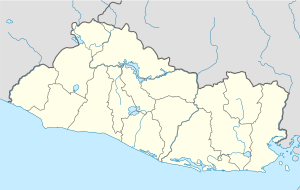Ahuachapán
| Ahuachapán | |
|---|---|
| Municipality | |

Bamboo in Ahuachapán
|
|
| Location in El Salvador | |
| Coordinates: 13°55′01″N 89°51′00″W / 13.91694°N 89.85000°W | |
| Country |
|
| Department | Ahuachapán Department |
| Founded | 1862 |
| Area | |
| • Municipality | 244.84 km2 (94.53 sq mi) |
| • Metro | 244.84 km2 (94.53 sq mi) |
| Elevation | 799 m (2,621 ft) |
| Population (2012) | |
| • Municipality | 38,108 |
| • Density | 160/km2 (400/sq mi) |
| • Metro | 110,511 |
| • Metro density | 450/km2 (1,200/sq mi) |
| Postal code | AH-01 |
| Website | www |
Ahuachapán is a city and municipality and the capital of the Ahuachapán Department in western El Salvador. The municipality including the city covers an area of 244.84 km² and as of 2007 has a population of 110,511 people. Situated near the Guatemalan border, it is the westernmost city in the country and is the center of an agricultural region producing primarily coffee.
Ahuachapán is the site of a geothermal power plant and a hydroelectric station. The local geothermal activity produces many steam vents, visible throughout the surrounding mountains.
Among other things, Ahuachapan is also the birthplace of notable Salvadoran poet Alfredo Espino and is about an hour's drive from the national wildlife park El Imposible.
Ahuachapán was founded by Mayan Indians of the Pokomanes tribe in the 5th century and invaded in the 15th century by the Izalcos. It officially gained city status on 11 February, 1862 and became the departmental capital on February 9, 1869.
The municipality of Ahuachapán is located 100 km from the capital city San Salvador. To the north it borders San Lorenzo and the Republic of Guatemala. It is surrounded by San Lorenzo, Atiquizaya and Turín; by Juayúa, Apaneca, and Tacuba to the south. The climate of the municipality is very warm with the temperatures oscillating between 22°C and 27°C.
The principal river is the Río Paz. There are other tributaries but the Río Paz forms a natural border between El salvador and Guatemala.
...
Wikipedia

